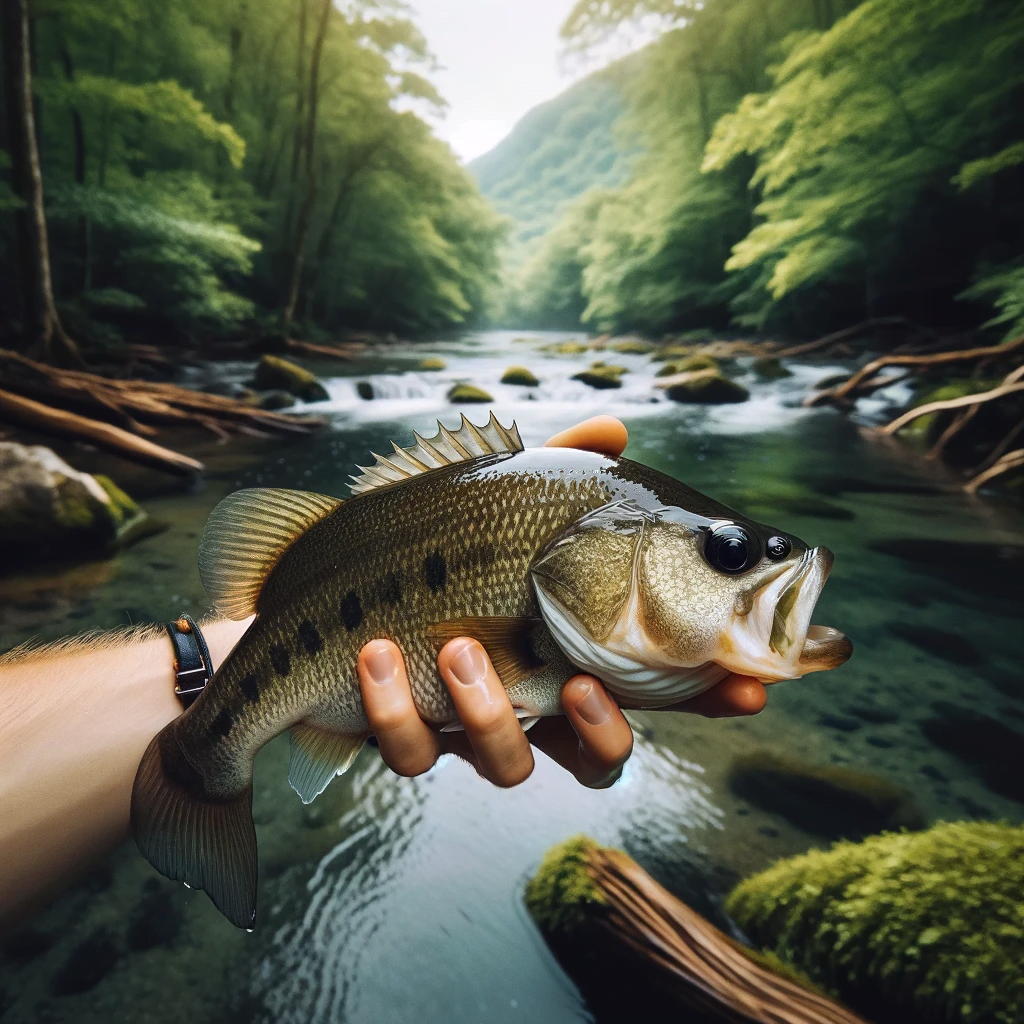Largemouth bass are one of the most popular freshwater game fish among anglers in the United States. But many people wonder – are largemouth bass saltwater or freshwater fish? This comprehensive article will provide a complete guide to answering that question.

Biology and Natural Habitat of Largemouth Bass
Largemouth bass (Micropterus salmoides) belong to the diverse sunfish family (Centrarchidae) and are native to freshwater lakes, rivers, ponds, and backwaters across central and eastern North America. They thrive as apex predators in warm, quiet waters across most of the eastern half of the US and Canada.
Several key identifying features help anglers distinguish largemouth bass from other species. They have a large, sloping mouth that extends behind the eye, gold-coloured eyes, a dark lateral line, a greenish-black back that fades to a light belly, and toothless bars running vertically along their greenish sides. Their sweeping dorsal fin is clearly separated from the deeply notched anal fin.
Juvenile largemouth bass start out just an inch or two long and stick close to shallow areas with dense aquatic vegetation, overhanging brush, submerged logs, and other structure that provides cover from predators. As they mature over 2-4 years, largemouth bass grow over 12 inches and become aggressive apex predators in their freshwater habitat, feeding on any prey they can capture and swallow including small fish, crayfish, frogs, salamanders, snakes, and insects.
During the spring spawning season when water temperatures climb above 60-65°F, male largemouth bass build saucer-shaped nests in shallow water, usually near cover. The males fan out the sandy bottoms with their tails to clear debris and attract females to lay their eggs in the nest. The males fertilize the eggs and guard the nests until the eggs hatch and the fry become free-swimming after about two weeks. Parental care by the male helps ensure the survival of young largemouth bass.
Largemouth Bass Are Freshwater Fish Not Found in Saltwater
While largemouth bass can tolerate moderate salinity levels, they cannot survive long-term in water with more than 10-12 parts per thousand (ppt) salinity. They require lower salinity levels to spawn and thrive. Largemouth bass are specifically adapted to freshwater environments.
In some tidal rivers, reservoirs, or estuaries, largemouth bass may venture into partly brackish water when migrating from their freshwater habitats. But they avoid spending prolonged time in higher salinity water. And they certainly cannot reproduce successfully or persist for long in brackish or saline conditions.
Sometimes largemouth bass are accidentally or intentionally stocked in estuaries, bays, or semi-saline lakes outside their native range by anglers hoping to establish new fisheries. But in nearly all cases, the stocked largemouth bass fail to create self-sustaining populations in those marginal saltwater environments. Largemouth bass depend on low-salinity freshwater ecosystems to grow, feed, spawn, and thrive.
Native Geographic Range and Habitats
Largemouth bass are native to freshwater lakes, rivers, wetlands and backwaters primarily in the central and eastern United States and Canada. Their native range extends:
- Throughout the southeastern U.S. from Texas to Florida and north along the Mississippi River drainage to Minnesota
- Throughout the lower Great Lakes region including lakes Erie and Ontario
- In southern Canada including the provinces of Ontario, Quebec, Manitoba, and Saskatchewan
Within their natural range, the best places to find and catch largemouth bass are weedy ponds, reservoirs, lakes, slow-moving rivers, oxbow lakes, backwaters, and other waters with ample shallow, quiet habitat. Submerged aquatic vegetation, fallen trees, stumps, rocks, docks and other structure provide ambush cover for these keen-eyed predators.
Outside of their native North American range, largemouth bass have been widely introduced across the world to stock freshwater fisheries including Africa, Europe, Asia, South America, and Hawaii. While stocking non-native fish can negatively impact local ecosystems, within North America, transferring bass between bodies of water within their historical range provides great fishing opportunities without disrupting indigenous species.

Impacts of Introducing Largemouth Bass
As apex predators in their native waters, largemouth bass help control populations of smaller fish and aquatic animals as part of a balanced ecosystem. But outside their natural range, introduced largemouth bass can have harmful impacts on native species not adapted to compete with or avoid predation by this aggressive fish. Negative ecological impacts can include:
- Driving dramatic declines in native prey fish, frogs, salamanders and other aquatic life not adapted to this new predator
- Competing with native predatory fish for food and habitat
- Spreading parasites or disease unknown in the local ecosystem
- Altering food webs by eliminating smaller native species
However, within North America, transferring largemouth bass from one water body to another within their broad historical range usually does not seriously disrupt indigenous ecosystems. Largemouth bass provide exciting recreational fishing opportunities when stocked in appropriate fisheries within their native continent.
Careful risk assessment helps fisheries managers weigh the benefits and risks of authorizing transfers to avoid environmental harm. Anglers should not move fish like largemouth bass between water bodies without oversight, as unauthorized introduction of apex predators into new watersheds can be ecologically devastating. Education and regulation aim to prevent invasive aquatic species spread.
How to Target and Catch Largemouth Bass
A versatile and popular sport fish, largemouth bass can be caught using a wide variety of tackle, techniques and baits. As ambush predators, they prefer lures that imitate vulnerable prey like baitfish, frogs, crayfish or injured fish. Dawn and dusk are prime times to target largemouth bass stalking the shallows. Here are some top tips for catching lunker bass:
- Fish around structure – target weedlines, points, docks, submerged brush, fallen trees, rocks or ledges that provide cover
- Gear tip – use a 6-7 foot medium power spinning or baitcast rod and reel spooled with 10-17 lb test mono or fluorocarbon line and leader
- Weedless rigs – wacky jigs, Texas rigs, swimbaits and other lures that won’t snag vegetation
- Topwater – buzzbaits, poppers, walking baits tempt explosive strikes at dawn/dusk
- Plastics – worms, creature baits, craws, fluke style baits are bass candy
- Swimbaits – imitation baitfish for provoking reaction bites
- Crankbaits – lipless or diving crankbaits imitate wounded baitfish
- Spinnerbaits – flash, vibration and movement to trigger strikes
- Jigs – finesse or flipping jigs worked slowly in heavy cover
- Focus on low light – target dawn, dusk, night, heavy cloud cover
- Spring – fish shallow warming spawning areas with fast moving baits
- Summer – fish deeper structure, early and late day periods are best
- Fall – use large noisy baits and bright colors to draw strikes
- Winter – downsize and slow down with jigs and subtle finesse techniques
Largemouth bass are aggressive hunters that will hit a variety lures, making them accessible and exciting to catch for anglers of all experience levels. Their hard fighting nature when hooked makes largemouth bass a popular sportfish across North America.
Largemouth Bass Significance and Fun Facts
- Nicknamed “bucketmouth” for their wide gape and appetite.
- Unofficial freshwater fish of the United States and a classic American game fish.
- Subject of countless fishing lore, tournaments, memorabilia, and more.
- Can reach over 10 pounds in size with the world record 22 lbs, 4 oz caught in Montgomery Lake, Georgia in 1932 by George Perry.
- A 12-16 inch largemouth is considered a trophy or “lunker” by most anglers.
- Prized more for the fight they provide when hooked rather than for their mediocre table fare.
- Can live over 15 years in the wild, but most caught are under 5 years old.
- Voracious ambush predators with excellent vision that explode from cover to engulf prey.
- Capable of eating prey up to half their own length and bigger than their mouth gape by expanding their stomach.
- Known for seeking cover and shade during bright, warm periods making fishing tough at midday in summer.
- During cold winters go dormant and feed infrequently, mostly on warmer sunny days.
In summary, largemouth bass are exclusively a freshwater species native to eastern and central North American lakes, rivers, and ponds. While they may occasionally venture into brackish tidal waters when migrating from their freshwater domains, largemouth bass cannot survive or reproduce in pure saltwater environments. Their popularity among recreational anglers cements the iconic largemouth bass as an American freshwater




